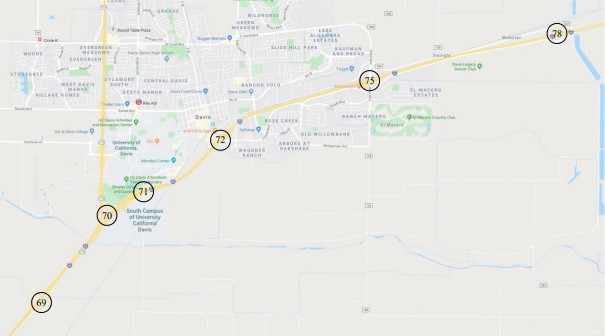News | PSR Researcher Michael Zhang Evaluates the Use of Variable Speed Limits to Mitigate Carbon Footprint
Stop the VideoNews

PSR
PSR Researcher Michael Zhang Evaluates the Use of Variable Speed Limits to Mitigate Carbon Footprint
Friday, January 29, 2021
The goal of reducing greenhouse gas emissions and fuel consumption stemming from vehicle usage calls for creative solutions in unexpected areas. Michael Zhang, Professor in the Department of Civil and Environmental Engineering at University of California, Davis, along with Graduate Researchers Hang Gao and Shenyang Chen, examined the potential of using variable speed limits (VSL) to lessen environmental damage. Variable speed limits allow the speed limit to vary depending on traffic conditions. Under the current practice of static speed limits, traffic congestion and the consequential stop-and-go flow of traffic on freeways increase travel delays, result in greater fuel consumption, and pose a greater crash risk to motorists. Using VSL, road users would travel under a lower speed limit on specific sections of the road (typically upstream of a bottleneck), instead of being under a single speed limit throughout the entire freeway. VSL is typically considered a strategy for mitigating accidents, improving road safety, and reducing crash likelihood in conditions such as harsh weather or construction areas. However, Zhang and his team, in the PSR-funded research project titled, “Get More Out of Variable Speed Limit (VSL) Control: An Integrated Approach to Manage Traffic Corridors with Multiple Bottlenecks,” focused on determining if VSL could be used to reduce fuel consumption and associated carbon dioxide emissions by mitigating traffic congestion.

A. Studied freeway section and contained junctions
The project was conducted using a microscopic traffic simulator— a model that simulates the movement of every vehicle in the network. The research team used a ten-mile-long stretch of Interstate 80 that has six junctions and three bottlenecks, mimicking conditions of the freeway that tend to disrupt traffic and lead to congestion. The researchers compared three different types of speed control:
- Flow-based VSL, which focuses on maintaining a maximum flow rate - the highest possible volume of vehicles passing through the downstream segments while avoiding congestion in order to save fuel;
- Density-based VSL, which sets and aims toward a target density (the number of vehicles occupying a given length of roadway), setting the speed limit by calculating the difference between the target density and measured density; and
- The standard static speed limit, used as a control for comparison.
Throughout their study, the researchers found that both VSL options result in a slight increase in travel time when compared to static speed limits. Flow-based VSL turned out to be ineffective in meeting the goal of reducing greenhouse gas emissions and actually performed worse than the standard use of static speed limits, since it controlled congestion in certain segments but transferred that congestion upstream in a way that worsened overall congestion. However, density-based VSL performed better than the others in terms of reducing fuel consumption and emissions by frequently adjusting the speed limit in a calculated manner and preventing overall traffic flow from breaking down.
B. Fuel uses versus speed limit on a 1-mile-long road segment
By measuring and comparing fuel consumption under a static speed limit to VSL methods, Zhang’s study found that imposing density-based VSL and segmented lower speed limits instead of a static speed limit based on free flow conditions improves fuel efficiency and carbon emissions, with the trade-off of a minor increase in travel time. According to the gathered data, density-based VSL reduces CO2 emissions by over 10% in each case. While VSL is not a cure-all solution to reducing greenhouse gas emissions and fuel consumption stemming from vehicle usage, density-based VSL offers further insight into the complexities of managing traffic congestion. The researchers intend to extend their work. They will integrate ramp metering and continue investigating multi-segment and multi-bottleneck corridors.
News Archive
- December (1)
- November (6)
- October (4)
- September (2)
- August (3)
- July (4)
- June (3)
- May (7)
- April (8)
- March (11)
- February (8)
- January (7)
- December (7)
- November (8)
- October (11)
- September (11)
- August (4)
- July (10)
- June (9)
- May (2)
- April (12)
- March (8)
- February (7)
- January (11)
- December (11)
- November (5)
- October (16)
- September (7)
- August (5)
- July (13)
- June (5)
- May (5)
- April (7)
- March (5)
- February (3)
- January (4)
- December (4)
- November (5)
- October (5)
- September (4)
- August (4)
- July (6)
- June (8)
- May (4)
- April (6)
- March (6)
- February (7)
- January (7)
- December (8)
- November (8)
- October (8)
- September (15)
- August (5)
- July (6)
- June (7)
- May (5)
- April (8)
- March (7)
- February (10)
- January (12)















